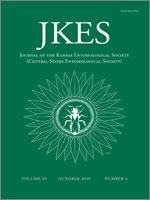William D. Wiesenborn
Journal of the Kansas Entomological Society 83 (4), 288-296, (1 October 2010) https://doi.org/10.2317/JKES0911.30.1
KEYWORDS: pollination, Boraginaceae, floral color change, nectar sugar, ultraviolet
Heliotropium curassavicum L. (Boraginaceae) is a small desert perennial producing inflorescences visited by Hesperopsis gracielae (MacNeill) (Lepidoptera: Hesperiidae), a skipper found along the lower Colorado River in Nevada, Arizona, and California. Flowers on H. curassavicum are white, with yellow centers that turn purple as flowers age, and absorb ultraviolet light. I found cymes supporting fewer yellow-centered flowers which contained greater masses of sugar. I compared attractions of H. gracielae adults to inflorescence models displaying the plant's floral colors. Skippers more-frequently approached or landed-on purple models compared with yellow models, and white models elicited fewer approaches than yellow or purple models. Attraction of sootywings to purple and yellow corresponded with numbers of purple- and yellow-centered flowers on inflorescences but not with masses of sugar in individual flowers. Models displaying yellow and purple together, or both colors plus white, elicited fewer approaches but equivalent landings compared with single-color models. Blocking ultraviolet light from multiple-color models greatly increased frequencies of responses, especially landings on models displaying white. Olfaction, tested by adding H. curassavicum inflorescences to multiple-color models, did not influence attraction. Each of the floral colors, especially purple, reflected by H. curassavicum inflorescences attract H. gracielae, whereas landings are most elicited by reflectance of all three colors without ultraviolet.

